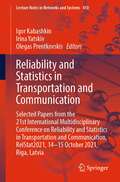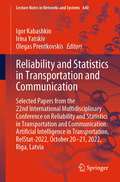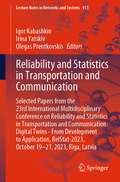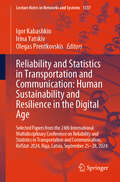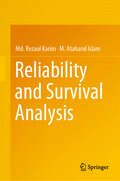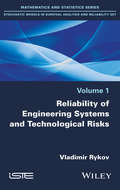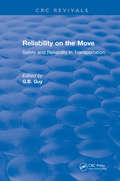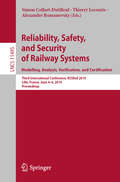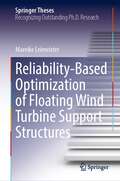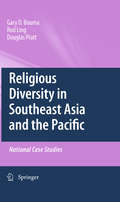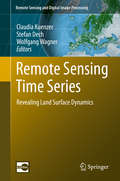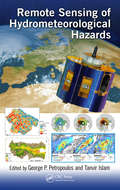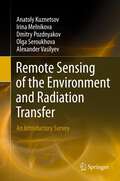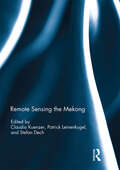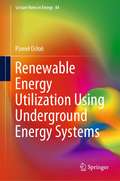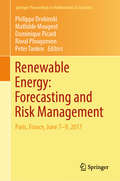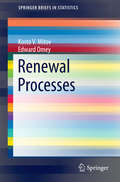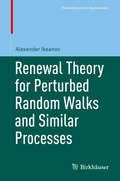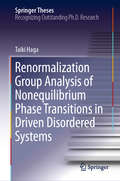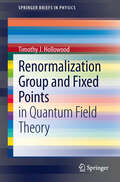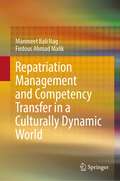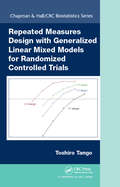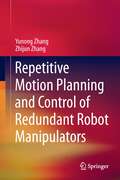- Table View
- List View
Reliability and Statistics in Transportation and Communication: Selected Papers from the 21st International Multidisciplinary Conference on Reliability and Statistics in Transportation and Communication, RelStat2021, 14-15 October 2021, Riga, Latvia (Lecture Notes in Networks and Systems #410)
by Igor Kabashkin Irina Yatskiv Olegas PrentkovskisThis book reports on cutting-edge theories and methods for analyzing complex systems, such as transportation and communication networks and discusses multi-disciplinary approaches to dependability problems encountered when dealing with complex systems in practice. The book presents the most noteworthy methods and results discussed at the 21st International Multidisciplinary Conference on Reliability and Statistics in Transportation and Communication (RelStat), which took place remotely from Riga, Latvia, on October 14 – 15, 2021. It spans a broad spectrum of topics, from mathematical models and design methodologies, to software engineering, data security and financial issues, as well as practical problems in technical systems, such as transportation and telecommunications, and in engineering education.
Reliability and Statistics in Transportation and Communication: Selected Papers from the 22nd International Multidisciplinary Conference on Reliability and Statistics in Transportation and Communication: Artificial Intelligence in Transportation, RelStat-2022, October 20-21, 2022, Riga, Latvia (Lecture Notes in Networks and Systems #640)
by Igor Kabashkin Irina Yatskiv Olegas PrentkovskisThis book reports on cutting-edge theories and methods for analyzing complex systems, such as transportation and communication networks and discusses multi-disciplinary approaches to dependability problems encountered when dealing with complex systems in practice. The book presents the most relevant findings discussed at the 22nd International Multidisciplinary Conference on Reliability and Statistics in Transportation and Communication (RelStat), which took place on October 20 – 21, 2022, in Riga, Latvia, in hybrid mode. It spans a broad spectrum of advanced theories and methods, giving a special emphasis to the integration of artificial intelligent concepts into reliability approaches.
Reliability and Statistics in Transportation and Communication: Selected Papers from the 23rd International Multidisciplinary Conference on Reliability and Statistics in Transportation and Communication: Digital Twins - From Development to Application, RelStat-2023, October 19-21, 2023, Riga, Latvia (Lecture Notes in Networks and Systems #913)
by Igor Kabashkin Irina Yatskiv Olegas PrentkovskisThis book reports on cutting-edge theories and methods for analyzing complex systems, such as transportation and communication networks and discusses multi-disciplinary approaches to dependability problems encountered when dealing with complex systems in practice. The book presents the most relevant findings discussed at the 23rd International Multidisciplinary Conference on Reliability and Statistics in Transportation and Communication (RelStat 2023), which took place as a hybrid event on October 19 – 21, 2023, in/from Riga, Latvia. It spans a broad spectrum of advanced theories and methods, giving a special emphasis to the digitalization of transport systems, as well as smart, artificial intelligence, and digital twins applications.
Reliability and Statistics in Transportation and Communication: Selected Papers from the 24th International Multidisciplinary Conference on Reliability and Statistics in Transportation and Communication, RelStat-2024, Riga, Latvia, September 25-28, 2024 (Lecture Notes in Networks and Systems #1337)
by Igor Kabashkin Irina Yatskiv Olegas PrentkovskisThis book reports on cutting-edge theories and methods for analyzing complex systems, such as transportation and communication networks and discusses multi-disciplinary approaches to dependability problems encountered when dealing with complex systems in practice. It presents the most relevant findings discussed at the 24th International Multidisciplinary Conference on Reliability and Statistics in Transportation and Communication (RelStat 2024), which took place as a hybrid event on September 25-28, 2024, in/from Riga, Latvia. The chapters span a broad spectrum of advanced theories and methods, with a special emphasis on smart technologies and algorithms for enhancing sustainability and resilience of transport systems in various sectors.
Reliability and Survival Analysis
by Md. Rezaul Karim M. Ataharul IslamThis book presents and standardizes statistical models and methods that can be directly applied to both reliability and survival analysis. These two types of analysis are widely used in many fields, including engineering, management, medicine, actuarial science, the environmental sciences, and the life sciences. Though there are a number of books on reliability analysis and a handful on survival analysis, there are virtually no books on both topics and their overlapping concepts. Offering an essential textbook, this book will benefit students, researchers, and practitioners in reliability and survival analysis, reliability engineering, biostatistics, and the biomedical sciences.
Reliability of Engineering Systems and Technological Risk
by Vladimir RykovIn this book three main aspects are considered together: mathematical models for engineering systems reliability, the main concepts for technogeneous risk study, and insurance as methods for risks management. In the first part the author considers some special statistical problems concerning reliability data elaboration. The second part deals with the strong mathematical concept of risks and some problems for technogeneous risks insurance.
Reliability on the Move: Safety and reliability in transportation
by G.B. GuyThis book represents the porceedings of the 1989 Safety and Reliability Society Symposium held in Bath on the 11th and 12th of October on that topic.
Reliability, Safety, and Security of Railway Systems. Modelling, Analysis, Verification, and Certification: Third International Conference, RSSRail 2019, Lille, France, June 4–6, 2019, Proceedings (Lecture Notes in Computer Science #11495)
by Alexander Romanovsky Thierry Lecomte Simon Collart-DutilleulThis book constitutes the refereed proceedings of the Third International Conference on Reliability, Safety, and Security of Railway Systems, RSSRail 2019, held in Lille, France in June 2019. The 18 full papers presented in this book were carefully reviewed and selected from 38 submissions. They cover a range of topics including railways system and infrastructure advance modelling; scheduling and track planning; safety process and validation; modelling; formal verification; and security.
Reliability-Based Optimization of Floating Wind Turbine Support Structures (Springer Theses)
by Mareike LeimeisterThis book pursues the ambitious goal of combining floating wind turbine design optimization and reliability assessment, which has in fact not been done before. The topic is organized into a series of very ambitious objectives, which start with an initial state-of-the-art review, followed by the development of high-fidelity frameworks for a disruptive way to design next generation floating offshore wind turbine (FOWT) support structures. The development of a verified aero-hydro-servo-elastic coupled numerical model of dynamics for FOWTs and a holistic framework for automated simulation and optimization of FOWT systems, which is later used for the coupling of design optimization with reliability assessment of FOWT systems in a computationally and time-efficient manner, has been an aim of many groups internationally towards implementing a performance-based/goal-setting approach in the design of complex engineering systems. The outcomes of this work quantify the benefits of an optimal design with a lower mass while fulfilling design constraints. Illustrating that comprehensive design methods can be combined with reliability analysis and optimization algorithms towards an integrated reliability-based design optimization (RBDO) can benefit not only the offshore wind energy industry but also other applications such as, among others, civil infrastructure, aerospace, and automotive engineering.
Religion in America (Sociology in the Twenty-First Century #6)
by Lisa D. Pearce Claire Chipman GillilandWritten in an engaging and accessible tone, Religion in America probes the dynamics of recent American religious beliefs and behaviors. Charting trends over time using demographic data, this book examines how patterns of religious affiliation, service attendance, and prayer vary by race and ethnicity, social class, and gender. The authors identify demographic processes such as birth, death, and migration, as well as changes in education, employment, and families, as central to why some individuals and congregations experience change in religious practices and beliefs while others hold steady. Religion in America challenges students to examine the demographic data alongside everyday accounts of how religion is experienced differently across social groups to better understand the role that religion plays in the lives of Americans today and how that is changing.
Religious Diversity in Southeast Asia and the Pacific
by Gary D. Bouma Rodney Ling Douglas PrattReligious diversity is now a social fact in most countries of the world. While reports of the impact of religious diversity on Europe and North America are reasonably well-known, the ways in which Southeast Asia and Asia Pacific are religiously diverse and the ways this diversity has been managed are not. This book addresses this lack of information about one of the largest and most diverse regions of the world. It describes the religious diversity of 27 nations, as large and complex as Indonesia and as small as Tuvalu, outlining the current issues and the basic policy approaches to religious diversity. Southeast Asia and the Pacific Islands are portrayed as a living laboratory of various religious blends, with a wide variance of histories and many different approaches to managing religious diversity. While interesting in their own right, a study of these nations provides a wealth of case studies of diversity management - most of them stories of success and inclusion.
Remote Sensing Time Series
by Wolfgang Wagner Claudia Kuenzer Stefan DechThis volume comprises an outstanding variety of chapters on Earth Observation based time series analyses, undertaken to reveal past and current land surface dynamics for large areas. What exactly are time series of Earth Observation data? Which sensors are available to generate real time series? How can they be processed to reveal their valuable hidden information? Which challenges are encountered on the way and which pre-processing is needed? And last but not least: which processes can be observed? How are large regions of our planet changing over time and which dynamics and trends are visible? These and many other questions are answered within this book "Remote Sensing Time Series Analyses - Revealing Land Surface Dynamics". Internationally renowned experts from Europe, the USA and China present their exciting findings based on the exploitation of satellite data archives from well-known sensors such as AVHRR, MODIS, Landsat, ENVISAT, ERS and METOP amongst others. Selected review and methods chapters provide a good overview over time series processing and the recent advances in the optical and radar domain. A fine selection of application chapters addresses multi-class land cover and land use change at national to continental scale, the derivation of patterns of vegetation phenology, biomass assessments, investigations on snow cover duration and recent dynamics, as well as urban sprawl observed over time.
Remote Sensing of Hydrometeorological Hazards
by Tanvir Islam George P. PetropoulosExtreme weather and climate change aggravate the frequency and magnitude of disasters. Facing atypical and more severe events, existing early warning and response systems become inadequate both in scale and scope. Earth Observation (EO) provides today information at global, regional and even basin scales related to agrometeorological hazards. This book focuses on drought, flood, frost, landslides, and storms/cyclones and covers different applications of EO data used from prediction to mapping damages as well as recovery for each category. It explains the added value of EO technology in comparison with conventional techniques applied today through many case studies.
Remote Sensing of the Environment and Radiation Transfer
by Alexander Vasilyev Dmitry Pozdnyakov Irina Melnikova Olga Seroukhova Anatoly KuznetsovThe interaction of the solar and heat radiation with the atmosphere and surface is the subject of the book. It is useful also for wide circle scientists involved in environmental studies. The book contains the description of 17 computer studying programs supporting different topics of courses. It includes only the base ground for comprehension of key topics and provides the accomplishment of practical works with using specially elaborated computer programs. Themes of practical works reflect main sections of mentioned courses of lectures. The packet of computer programs is added for solution of direct and inverse problems. It promotes deep and reliable comprehension of corresponding topics by students. All described approaches and computer programs are valuable resources for solving radiative transfer problems and they could be used by students for courses and diploma studies concerned atmospheric optics.
Remote Sensing the Mekong
by Claudia Kuenzer Stefan Dech Patrick LeinenkugelThe Mekong Basin in Southeast Asia is one of the largest international river basins in the world. Its abundant natural resources are shared by six riparian countries and provide the basis for the livelihoods of more than 75 million people. However, ongoing socio-economic growth and related anthropogenic interventions impact the region’s ecosystems, and there is an urgent need for the monitoring of the basin's land surface dynamics. Remote sensing has evolved as a key tool for this task, allowing for up-to-date analyses and regular monitoring of environmental dynamics beyond physical or political boundaries and at various temporal and spatial scales. This book serves as a forum for remote-sensing scientists with an interest in the Mekong River Basin to present their recent basin-related works as well as applied case studies of the region. A broad range of sensors from high to medium resolution, and from multispectral to SAR systems, are applied, covering topics such as land cover/land use classification and comparison, time series analyses of climate variables, vegetation structure and vegetation productivity, as well as studies on flood mapping or water turbidity monitoring. This book was originally published as a special issue of the International Journal of Remote Sensing.
Renewable Energy Utilization Using Underground Energy Systems (Lecture Notes in Energy #84)
by Paweł OcłońThis book discusses heat transfer in underground energy systems. It covers a wide range of important and practical topics including the modeling and optimization of underground power cable systems, modeling of thermal energy storage systems utilizing waste heat from PV panels cooling. Modeling of PV pannels with cooling. While the performance of energy systems which utilize heat transfer in the ground is not yet fully understood, this book attempts to make sense of them. It provides mathematical modeling fundaments, as well as experimental investigation for underground energy systems. The book shows detailed examples, with solution procedures. The solutions are based on the Finite Element Method and the Finite Volume Method. The book allows the reader to perform a detailed design of various underground energy systems, as well as enables them to study the economic aspects and energy efficiency of underground energy systems. Therefore, this text is of interest to researchers, students, and lecturers alike.
Renewable Energy: Paris, France, June 7-9, 2017 (Springer Proceedings in Mathematics & Statistics #254)
by Philippe Drobinski Mathilde Mougeot Dominique Picard Riwal Plougonven Peter TankovGathering selected, revised and extended contributions from the conference ‘Forecasting and Risk Management for Renewable Energy FOREWER’, which took place in Paris in June 2017, this book focuses on the applications of statistics to the risk management and forecasting problems arising in the renewable energy industry. The different contributions explore all aspects of the energy production chain: forecasting and probabilistic modelling of renewable resources, including probabilistic forecasting approaches; modelling and forecasting of wind and solar power production; prediction of electricity demand; optimal operation of microgrids involving renewable production; and finally the effect of renewable production on electricity market prices. Written by experts in statistics, probability, risk management, economics and electrical engineering, this multidisciplinary volume will serve as a reference on renewable energy risk management and at the same time as a source of inspiration for statisticians and probabilists aiming to work on energy-related problems.
Renewal Processes
by Kosto V. Mitov Edward OmeyThis monograph serves as an introductory text to classical renewal theory and some of its applications for graduate students and researchers in mathematics and probability theory. Renewal processes play an important part in modeling many phenomena in insurance, finance, queuing systems, inventory control and other areas. In this book, an overview of univariate renewal theory is given and renewal processes in the non-lattice and lattice case are discussed. A pre-requisite is a basic knowledge of probability theory.
Renewal Theory for Perturbed Random Walks and Similar Processes
by Alexander IksanovThis book offers a detailed review of perturbed random walks, perpetuities, and random processes with immigration. Being of major importance in modern probability theory, both theoretical and applied, these objects have been used to model various phenomena in the natural sciences as well as in insurance and finance. The book also presents the many significant results and efficient techniques and methods that have been worked out in the last decade. The first chapter is devoted to perturbed random walks and discusses their asymptotic behavior and various functionals pertaining to them, including supremum and first-passage time. The second chapter examines perpetuities, presenting results on continuity of their distributions and the existence of moments, as well as weak convergence of divergent perpetuities. Focusing on random processes with immigration, the third chapter investigates the existence of moments, describes long-time behavior and discusses limit theorems, both with and without scaling. Chapters four and five address branching random walks and the Bernoulli sieve, respectively, and their connection to the results of the previous chapters. With many motivating examples, this book appeals to both theoretical and applied probabilists.
Renormalization Group Analysis of Nonequilibrium Phase Transitions in Driven Disordered Systems (Springer Theses)
by Taiki HagaThis book investigates phase transitions and critical phenomena in disordered systems driven out of equilibrium. First, the author derives a dimensional reduction property that relates the long-distance physics of driven disordered systems to that of lower dimensional pure systems. By combining this property with a modern renormalization group technique, the critical behavior of random field spin models driven at a uniform velocity is subsequently investigated. The highlight of this book is that the driven random field XY model is shown to exhibit the Kosterlitz–Thouless transition in three dimensions. This is the first example of topological phase transitions in which the competition between quenched disorder and nonequilibrium driving plays a crucial role. The book also includes a pedagogical review of a renormalizaion group technique for disordered systems.
Renormalization Group and Fixed Points
by Timothy J HollowoodThis Brief presents an introduction to the theory of the renormalization group in the context of quantum field theories of relevance to particle physics. Emphasis is placed on gaining a physical understanding of the running of the couplings. The Wilsonian version of the renormalization group is related to conventional perturbative calculations with dimensional regularization and minimal subtraction. An introduction is given to some of the remarkable renormalization group properties of supersymmetric theories.
Repatriation Management and Competency Transfer in a Culturally Dynamic World
by Firdous Ahmad Malik Manmeet Bali NagThis book examines the relevance of global strategic perspective, as international competition continues to intensify & gain momentum, and management of human resource remains a challenge in contemporary corporate scenario. As global business strategy requires globally competent people and implementation of global human resource systems, therefore the need to harness the multi-faceted dimensions of corporate employees is elaborated upon. This book explores cross cultural movement & interactions in International human resource management, where the theme of cross-cultural reentry remains largely neglected and underestimated in the sojourner’s transition trajectory. This book takes into account the available empirical investigations pointing to substantial concerns, affecting the psychological wellbeing, social readjustment and cultural identity of the returning individuals. This book examines the significance of re-entry as an issue of highest priority to both sojourning individuals as well as people managing the reentry transitions of travelers. In light of the unfolding knowledge revolution, the book explores the context of corporate India offering high knowledge density and rich demographic dividend. The need for companies, to harness the knowledge capital and accelerate Indians in the knowledge revolution is examined. Various factors that can influence the repatriation of an individual when back in the home country, and the challenges faced in repatriation at the individual-, team-, organizational-, and country-levels, is explored & analyzed. This book focuses on eliminating overall wastage and losses in Repatriation process, from an organizational point of view.The purview of this book encompasses the interface of Anticipatory Adjustment, Competency Transfer, Effective Repatriation and Reverse Culture Shock with Repatriates’ Adjustment, back home, and empirically analyzes the precursors and effects of the said paradigms in optimization of Repatriate talent from an organizational perspective. The purpose is to analyze the antecedents of repatriate adjustment in the mentioned context and to subsequently deliberate upon the acquired results to arrive at feasible and relevant conclusions. Optimization of Repatriate talent, and Repatriation Management from International Human Resource Management (IHRM) perspective, deserves a cross-disciplinary study of precursors effecting Repatriation Adjustment, with focus on the dimension of Indian Repatriate acculturation.
Repeated Games
by Shmuel Zamir Jean-François Mertens Sylvain SorinThree leading experts have produced a landmark work based on a set of working papers published by the Center for Operations Research and Econometrics (CORE) at the Université Catholique de Louvain in 1994 under the title 'Repeated Games', which holds almost mythic status among game theorists. Jean-François Mertens, Sylvain Sorin and Shmuel Zamir have significantly elevated the clarity and depth of presentation with many results presented at a level of generality that goes far beyond the original papers - many written by the authors themselves. Numerous results are new, and many classic results and examples are not to be found elsewhere. Most remain state of the art in the literature. This book is full of challenging and important problems that are set up as exercises, with detailed hints provided for their solutions. A new bibliography traces the development of the core concepts up to the present day.
Repeated Measures Design with Generalized Linear Mixed Models for Randomized Controlled Trials (Chapman & Hall/CRC Biostatistics Series)
by Toshiro TangoRepeated Measures Design with Generalized Linear Mixed Models for Randomized Controlled Trials is the first book focused on the application of generalized linear mixed models and its related models in the statistical design and analysis of repeated measures from randomized controlled trials. The author introduces a new repeated measures design called S:T design combined with mixed models as a practical and useful framework of parallel group RCT design because of easy handling of missing data and sample size reduction. The book emphasizes practical, rather than theoretical, aspects of statistical analyses and the interpretation of results. It includes chapters in which the author describes some old-fashioned analysis designs that have been in the literature and compares the results with those obtained from the corresponding mixed models. The book will be of interest to biostatisticians, researchers, and graduate students in the medical and health sciences who are involved in clinical trials. Author Website:Data sets and programs used in the book are available at http://www.medstat.jp/downloadrepeatedcrc.html
Repetitive Motion Planning and Control of Redundant Robot Manipulators
by Zhijun Zhang Yunong ZhangRepetitive Motion Planning and Control of Redundant Robot Manipulators presents four typical motion planning schemes based on optimization techniques, including the fundamental RMP scheme and its extensions. These schemes are unified as quadratic programs (QPs), which are solved by neural networks or numerical algorithms. The RMP schemes are demonstrated effectively by the simulation results based on various robotic models; the experiments applying the fundamental RMP scheme to a physical robot manipulator are also presented. As the schemes and the corresponding solvers presented in the book have solved the non-repetitive motion problems existing in redundant robot manipulators, it is of particular use in applying theoretical research based on the quadratic program for redundant robot manipulators in industrial situations. This book will be a valuable reference work for engineers, researchers, advanced undergraduate and graduate students in robotics fields. Yunong Zhang is a professor at The School of Information Science and Technology, Sun Yat-sen University, Guangzhou, China; Zhijun Zhang is a research fellow working at the same institute.
